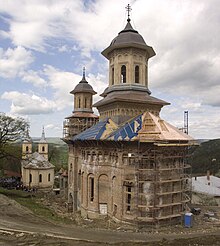Nicula Monastery
The Monastery Nicula [ Nikula ] is a monastery of Byzantine rite in Fizeşu Gherlii , Transylvania , Romania . The patronage of the monastery church is the Assumption of Mary . The Nicula pilgrimage site was founded in the 18th century as a Greek Catholic pilgrimage site. The pilgrims visit a picture of Mary that is said to have wept in 1699. Something similar was reported in 1696 about the miraculous image of Máriapócs in eastern Hungary. This is now in Vienna's St. Stephen's Cathedral .
With the advent of glassworks and under Austrian influence, a school for reverse glass painting was established here as early as the 18th century . The masters have mostly remained anonymous. Among the masters who have become known are three of German origin: Emil Weiss , Moritz Hachmann and Karl Müller .
In 1936, Greek Catholic monks were settled in Nicula, which at the time served as a simple chapel . They were arrested by the communist regime in autumn 1948 . Immediately afterwards, on December 18, 1948, four Romanian Orthodox monks were settled in the monastery .
After the fall of communism and the readmission of the Romanian Greek Catholic Church in 1989, the latter tried in vain to reach an amicable agreement with the Orthodox Church regarding the common use of the monastery. The agreement failed occasionally because of the resistance of the orthodox metropolitan of the Cluj Metropolis (Roman Mitropolia Clujului) , Bartolomeu Anania . The conflict between the Romanian Orthodox and Romanian Greek Catholic Churches that arose as a result of the expropriation of 1948 was examined in detail by Philippe Henri Blasen on the basis of the Orthodox and Greek Catholic histories. Bubbles concludes that Nicula is a prime example of the incompatible positions of the two churches.
Every year tens of thousands of believers make a pilgrimage to Nicula on August 15th. The Orthodox celebrate the service in the old monastery, while the Catholics celebrate the liturgy of the Assumption outside the monastery in the newly built village parish church.
Remarks
- ^ Philippe Henri blisters: Le Miracle de Nicula: confrontation du procès-verbal de l'enquête (1699), de Maria Virgo Claudiopolitana (1714) et de l'Historia Thaumaturgae Virginis Claudiopolitanae (173 [6]). In: Studia Universitatis Babeş-Bolyai Theologia catholica, No. 1, 2013
- ↑ Heinz Heltmann, Gustav Servatius (ed.): Travel Guide Transylvania. Wort und Welt Verlag, Thaur near Innsbruck 1993, ISBN 3-85373-133-3 , p. 33.
- ^ Philippe Henri blisters: L'évêque Iuliu Hossu et Nicula: du mănăstire au monastère (1936). In: Studia Universitatis Babeş-Bolyai Theologia catholica, No. 2, 2011
- ^ Website of the monastery, accessed on August 23, 2009
- ^ Philippe Henri bubbles: Le Cas Nicula. Analysis of the interactions entre les Eglises orthodoxe et gréco-catholique roumaines par l'étude de leurs historiographies respectives sur le lieu de pèlerinage de Nicula. Editura Mega, Cluj-Napoca 2011, ISBN 978-6-06-543182-9 .
Web links
Coordinates: 47 ° 0 ′ 8 ″ N , 23 ° 57 ′ 25 ″ E


